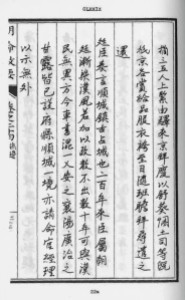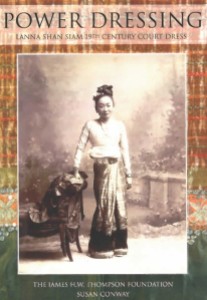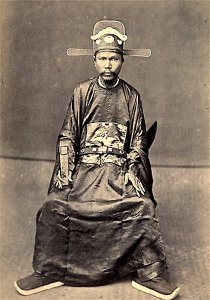I pointed out a long time ago on this blog (here) that there are nineteenth-century Vietnamese texts that refer to Vietnamese as “Hán” 漢. In responding to a question by a reader, and in thinking about some things I’ve read recently, I realize now that this term needs to be investigated more closely.
There is, for example, an entry for the 13th year of Minh Mạng’s reign in a chapter on “assuaging the frontier” [phủ biên 撫邊] in the Minh Mệnh chinh yếu that is as follows:
“An official submitted a memorial, stating that ‘Thuận Thành Defense Command is the old Chiêm Thành [i.e., Champa]. For the past 200 years it has been a vassal of the court and has been gradually imbued with the Han style [Hán phong 漢風]. With additional administrative measures and moral teachings [chính giáo 政教], within several decades [the people] will be no different from Han people [Hán dân 漢民]. At present, carriages and writing are united [車書混一]. Tương Dương in Nghệ An and Cam Lộ in Quảng Trị have both established prefectures and districts. We request that you appoint officials to administer the area of Thuận Thành so as demonstrate that there are no exceptions [以示無外].’” [明命正要卷之二十四,撫邊第二十一,22a]
So what was this “Han style” that had gradually been imbuing [nhiễm 染] the Cham? Were all Cham effected by this? Or only the elite? Or perhaps it was only the people whom the Nguyễn interacted with?
The expression that I have loosely translated as “carriages and writing are united” refers to an idea that was first expressed in a passage in the Zhongyong 中庸 where it says that “Now across All Under Heaven, carriages are on the same track, writing follows the same patterns, and behavior accords with the same mores” [今天下,書同文、車同軌、行同倫].
While “carriages and writing are united” can just mean that the realm is unified, I think that there are also some moral and political connotations to this expression as well. Ultimately I think that what this official was hoping for was not only that the realm be unified and administered in the same way everywhere, but that the people in the realm all live peacefully and remain loyal to the court as well.
How did you get people to do that? You did it at least in part through “administrative measures and moral teachings.”
So when this official stated that “With additional administrative measures and moral teachings [chính giáo 政教], within several decades [the people] will be no different from Han people [Hán dân 漢民],” what was he actually saying here? Would everyone speak the same language? There was no public school system at the time, and the main language taught in what schools there were was classical Chinese, so it is doubtful that being the same as Han people meant that people would all speak the same language.
Did it mean that everyone would be able to read classical Chinese? This didn’t apply to many commoners in places like the Red River delta, so it’s doubtful that it would apply in this case either.
So what did it mean to “become” a Han person?
There is an entry for the 18th year of Minh Mạng’s reign in this same chapter in which notes that Minh Mạng was upset that after an uprising by “evil savages” [ác man 惡蠻] in a part of Bình Thuận, and after he had given orders that taxes be reduced and the people be assuaged, that the area was still not peaceful.
Minh Mạng thereupon dispatched an official to investigate, and that person reported that since the hostilities had been pacified, the population was not as numerous as it previously had been, but that life was stabilizing.
This official then reported that “As for language and clothing, it is gradually becoming similar to that of Han people.”
How can that be? How does language and clothing change “gradually” in the aftermath of an uprising? Did the “savages” change their dress and language? If so, where did they get the clothes, how did they pay for them, and where did they take “language lessons”? What could they say? Who did this official talk to? Did he test the linguistic ability of numerous people in the region? Or perhaps it was the case that the Han people in the area were the only ones who had stayed after the uprising (hence the smaller population).
Passages like these ones above lead to numerous questions that have yet to be asked or answered.
Here I’m reminded of a book on the dress at the courts of various polities in what is now the northern parts of Burma, Thailand and Laos called Power Dressing. This book was meant to accompany an exhibit of court dress from the small kingdoms in that area in the late nineteenth century.
Although this book does not provide a detailed discussion of this topic, what it does make clear is that clothing was a very important tool for “performing” power.
This must have been the same in nineteenth-century Vietnam as well. Certainly local elites “performed” their loyalty to the Nguyễn court through the way they dressed, and I’m sure that they likewise “performed” their power through the way they dressed to the local people around them. In some cases people probably did this by using the clothing they obtained from the central court, and in other cases they didn’t, and in yet other cases they probably came up with some hybrid attire.
Dress was likely also a way that Nguyễn Dynasty officials “saw” loyalty. Han people were people who were loyal to the court. What I wonder, however, is who had to dress like a Han person (or how many people had to dress that way) for a Nguyễn Dynasty official to “view” a region as one consisting of Han people?
The book Power Dressing suggests that in some cases it did not require many at all, just the local officials, and only when they were meeting with officials from the central court or the tributary overlord.
So what was the situation in nineteenth-century Vietnam? Who were Han people? How did one “become” a Han person? And what role did clothing and language play in this? And what language?
So many questions, so few answers.








This Post Has 3 Comments
Đại Nam Thực Lục mentions that the three sons of Bà Ȃn, a Cham prince were given administrative or military positions and they adopted “Han” attire. This was in 1693 during the time of Nguyễn Phúc Chu.
大南實錄前篇 卷七 :
八月改順城鎮為平順府,以左茶員繼婆子為勘理,婆恩三子為提督、提領、該府。易衣服從漢風,遣之還以撫其民。
Typo. It should be “婆恩子三人” instead of “婆恩三子”.
Thank you very much for pointing this out!! I recently came across a vague reference to this, but now I see the actual details. Very interesting.
Someone could do a wonderful study of this across the region, from the Nguyen giving robes to the Cham, the Qing giving robes to the Tay Son
http://leminhkhai.wordpress.com/2012/04/08/evils-of-qu%E1%BB%91c-ng%E1%BB%AF-6/
The Siamese giving robes to the rulers of Lanna and the Khmer king, the Burmese giving robes to the Shan, etc.
And going way back in time to the lạc generals with their “bronze seals on green ribbons” which were certainly granted by someone else. . .
交州外域記曰,交趾昔未有郡縣之時,土地有雒田,其田從潮水上下,民墾食其田,名為雒民。設雒王雒侯主諸郡縣。縣多為雒將。雒將銅印青綬。
“The Record of the Outer Territory of Jiao Region states that ‘In the past, before Jiaozhi had commanderies and districts, the land had lạc fields. These fields followed the rising and falling of the floodwaters. The people who opened these fields for cultivation were called lạc people. Lạc princes and lạc marquises were appointed to control the various commanderies and districts. Many of the districts had lạc generals. The lạc generals had bronze seals on green ribbons.’”